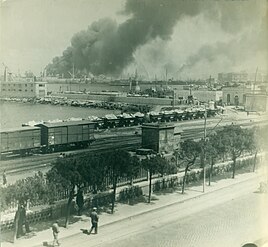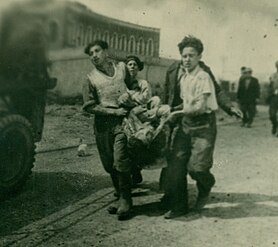 Charles Henderson was a standard liberty ship, similar to SS John W. Brown, seen here. Charles Henderson was a standard liberty ship, similar to SS John W. Brown, seen here.
| |
| History | |
|---|---|
| United States | |
| Name | Charles Henderson |
| Namesake | Charles Richmond Henderson |
| Builder | Delta Shipbuilding Company, New Orleans, Louisiana |
| Yard number | 1043 |
| Laid down | 29 March 1943 |
| Launched | 1 May 1943 |
| Completed | 19 May 1943 |
| Out of service | 9 April 1945 |
| Fate | Exploded while unloading cargo at Bari, Italy, 9 April 1945 |
| General characteristics | |
| Class and type | Type EC2-S-C1 Liberty ship |
| Propulsion | Single screw |
SS Charles Henderson was a Liberty ship constructed during World War II. It was destroyed in an ammunition explosion on April 9, 1945.
Namesake
One source states that the vessel was named after Charles Richmond Henderson (1848–1915), a Baptist clergyman and sociologist. Another source claims that it was named in honour of Charles Henderson, the Governor of Alabama.
Service
The vessel was operated by the Mississippi Shipping Company, based in New Orleans, on behalf of the War Shipping Administration, starting from 1943.
On 21 January 1944, the Charles Henderson collided with the coastal tanker MV Plattsburgh Socony near Cape Henlopen, Delaware. The collision resulted in a fire on the tanker. "Fourth Naval District officers said one of the ships burst into flames after the collision and was abandoned an hour later." One seaman was reported missing, and four others suffered burns. "A navy picket boat drew alongside the burning tanker – and 'stayed despite the danger of the ship exploding at any moment' – to rescue four crewmen marooned on the bow. Other survivors escaped in a lifeboat."
Loading in June 1944, the Charles Henderson was one of many vessels at Normandy for the invasion of Europe.
The ship sailed from New York City on 25 February 1945, bound for Norfolk, Virginia. There it loaded 6,675 tons of aircraft bombs in its holds. With loading complete, it steamed for Bari, Italy on 9 March, but returned the same day to repair its condenser's main induction valve. The ship waited five days for the next Mediterranean-bound convoy, UGS-80. Upon arriving at Gibraltar, the Charles Henderson proceeded independently to Bari, via Augusta, Sicily, arriving 5 April.
Fate
In one of the largest ammunition disasters of World War II, the Charles Henderson was being unloaded at berth 14 at Bari, in Southern Italy, on 9 April 1945, when she was destroyed in a high order explosion. "This detonation caused by 500 pound bombs loaded with Composition B, killed 542 and injured 1,800. It is believed the bombs were hooked and dragged to the well, then lifted without mats. The crew may have hurried because the contract paid by number of items lifted. Buildings along the waterfront were destroyed for 2,000 feet . Ships were severely damaged to 2,100 feet ."

Thirty-nine crew and 13 Armed Guard were killed in the explosion. The only survivor was the chief engineer, who was ashore at the time of the blast. The wreck remained in Bari until 1948, when it was sold for scrap.
See also
Gallery
-
 9 April 1945 - View from the barracks
9 April 1945 - View from the barracks
-
 9 April 1945
9 April 1945
-
 9 April 1945
9 April 1945
-
 9 April 1945
9 April 1945
-
 9 April 1945
9 April 1945
-
 9 April 1945
9 April 1945
References
- ^ Davies, James. "'LIBERTY' CARGO SHIP" (PDF). ww2ships.com. Archived (PDF) from the original on 5 May 2017. Retrieved 1 February 2017.
- "People Behind the Names H". Archived from the original on 17 August 2016. Retrieved 1 February 2017.
- "Governor Charles Henderson". Archived from the original on 7 November 2015. Retrieved 1 February 2017.
- "LibShipsC". Archived from the original on 20 July 2019. Retrieved 1 February 2017.
- "Allegheny II (Fleet Tug No. 19)". Archived from the original on 8 April 2021. Retrieved 1 February 2017.
- United Press, "Ships Collide Off East Coast; Fiery Sea of Oil Seen", The San Bernardino Daily Sun, San Bernardino, California, Saturday 22 January 1944, Volume 50, page 2.
- Associated Press, "Navy Saves Four Men on Burning Tanker", The Spokesman-Review, Spokane, Washington, Sunday 23 January 1944, Volume 61, Number 254, page 2.
- "American Merchant Marine Ships at Normandy in June 1944". Archived from the original on 24 June 2016. Retrieved 1 February 2017.
- ^ Braving the Wartime Seas: A Tribute to the Cadets and Graduates of the U.S. Merchant Marine Academy and Cadet Corps Who Died during World War II. Xlibris Corporation. 2014. ISBN 9781493186136.
- ^ "Chronological List of U.S. Ships Sunk or Damaged during 1945". Archived from the original on 25 March 2017. Retrieved 1 February 2017.
- file:///C:/Users/customer/Downloads/ADA507027.pdf
 This article incorporates text from this source, which is in the public domain.
This article incorporates text from this source, which is in the public domain.